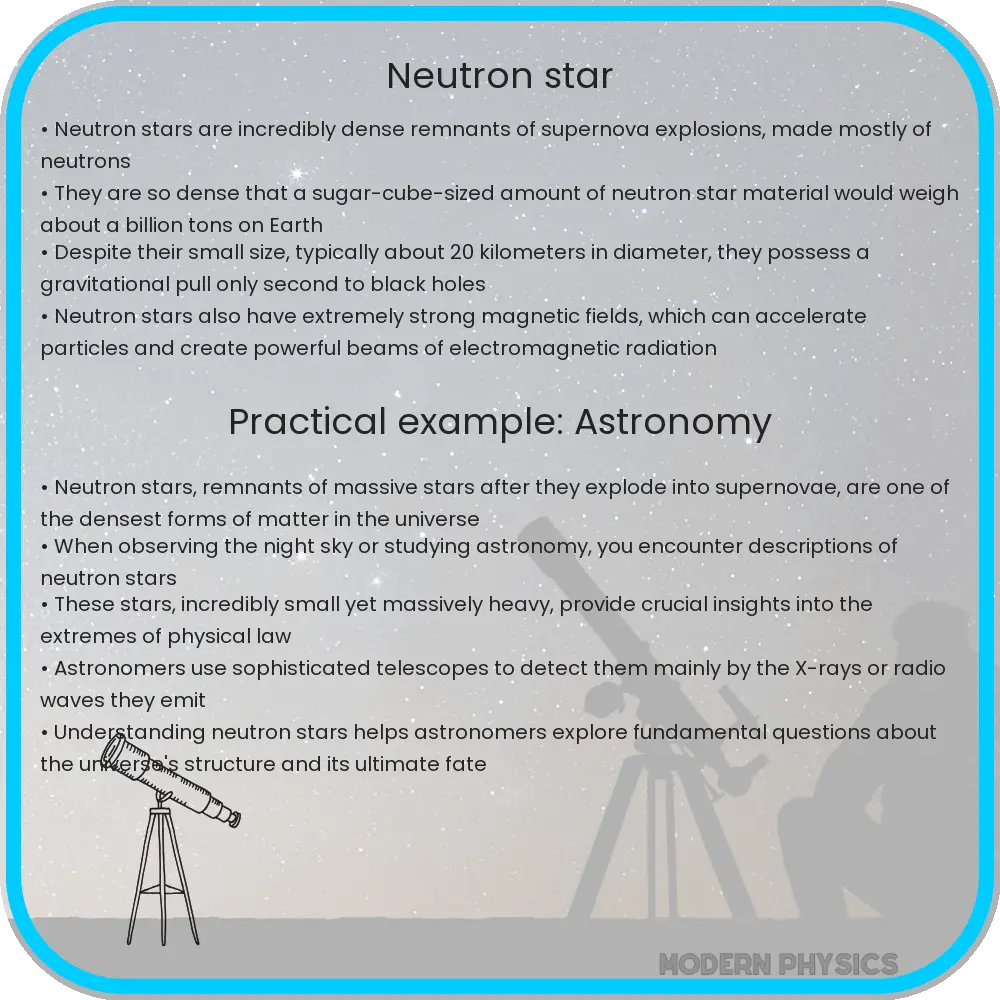Neutron stars, remnants of massive stars post-supernova, are one of the densest forms of matter in the universe, exhibiting extreme physical properties.

Introduction to Neutron Stars
Neutron stars are one of the most intriguing and extreme phenomena in the universe. They are the remnants of massive stars which have undergone a catastrophic collapse under gravity, leading to one of the densest forms of matter in existence. This article explores the formation, primary properties, and significance of neutron stars in the field of astronomy.
Formation of Neutron Stars
Neutron stars begin their life in the aftermath of a supernova explosion, a stellar explosion that occurs at the end of a massive star’s life cycle. To understand the formation of a neutron star, one must first look at the life cycle of a star that is significantly more massive than our Sun.
- Stellar Life Cycle: Stars that are about 10 times more massive than the Sun use up their nuclear fuel much faster than smaller stars. As the massive star consumes its hydrogen through nuclear fusion, it creates heavier elements in its core, culminating in the production of iron.
- Core Collapse: Unlike lighter elements, iron does not release energy when fused. As a result, once a star’s core is iron, fusion stops, and the core no longer has an outward pressure to counterbalance gravity. This leads to a rapid, catastrophic collapse of the core.
- Supernova Explosion: The collapsing core leads to a bounce back and shock waves that cause the outer layers of the star to explode in a supernova. The supernova releases a tremendous amount of energy and briefly outshines an entire galaxy.
- Neutron Star Formation: If the remaining core of the star after the supernova explosion has a mass between about 1.4 and 2.16 times that of the Sun (known as the Tolman-Oppenheimer-Volkoff limit), it collapses further into a neutron star. For masses greater than this, the result would be a black hole instead.
Properties of Neutron Stars
Neutron stars possess several extreme properties due to their intense density and compact nature:
- Size and Density: Despite being only around 10 to 20 kilometers in diameter, a typical neutron star can have as much mass as 1.5 times that of the Sun. This leads to incredible densities, where a sugar-cube-sized amount of material from a neutron star would weigh about a billion tons on Earth.
- Gravitational Field: The gravitational field at the surface is about 2*1011 times stronger than Earth’s gravitational field, meaning that objects near a neutron star would experience immense gravitational pull.
- Magnetic Fields: Neutron stars also possess extremely strong magnetic fields, which can be more than a trillion times stronger than Earth’s magnetic field. These magnetic fields slow the star’s spin over time and power the emission of electromagnetic radiation, which we can observe as pulsars.
- Spin Rate: When a star collapses into a neutron star, conservation of angular momentum means that it spins much faster than it did as a massive star. Neutron stars can rotate at up to several hundred times per second after their formation.
These properties make neutron stars some of the most fascinating objects in the known universe, with conditions that are impossible to replicate on Earth or with our current technology. The study of these remnants allows astrophysicists to explore laws of physics under extreme conditions.
Significance of Neutron Stars in Astronomy
Neutron stars offer invaluable insights into the physics of the cosmos. They serve as natural laboratories for studying matter under extreme pressures and densities that cannot be achieved on Earth. Observations of neutron stars can help scientists test the limits of physical theories, including general relativity and quantum mechanics.
- Pulsars: Some neutron stars are observed as pulsars. These are highly magnetized, rotating neutron stars that emit beams of electromagnetic radiation out of their magnetic poles. This radiation can be detected on Earth when a beam is pointed directly toward us, appearing as pulses due to the star’s rotation.
- Gravitational Waves: Neutron stars are also part of groundbreaking research in the detection of gravitational waves. When two neutron stars orbit each other and eventually merge, they emit gravitational waves that can be detected by observatories like LIGO and Virgo. These detections provide deep insights into the properties of neutron stars and the nature of gravity.
- X-ray Emissions: Many neutron stars are also strong sources of X-rays, which are studied using space-based telescopes. These observations help astronomers understand the neutron star’s surface composition and magnetic field structure.
Thus, studying these extraordinary objects not only pushes the boundaries of known physics but also deepens our understanding of the universe.
Neutron Stars and the Future of Astronomy
The ongoing research and future missions aimed at observing and understanding neutron stars promise to uncover more about the fundamental laws that govern our universe. With advancements in technology and techniques, such as more sensitive detectors and international cooperation in telescope networks, astronomers are poised to delve even deeper into the mysteries posed by neutron stars.
International collaborations, like those formed for the Event Horizon Telescope which captured the first image of a black hole, are crucial. Similar endeavors could provide more detailed observations of neutron stars, helping to untangle the complex interactions at play in these extreme environments.
In conclusion, the study of neutron stars is not just about understanding these fascinating objects themselves, but also about using them as tools to probe the broader physical laws that shape our universe. From testing theories of gravity and matter at their extremes to aiding in our search for gravitational waves, neutron stars are central to many of the most exciting and forward-thinking areas in contemporary astronomy. As we continue to innovate and refine our observational techniques, the mysteries unlocked by neutron stars will likely illuminate other, deeper questions about the nature of reality itself.
